Do you have a question about the Arctic Cat ATV 2005 and is the answer not in the manual?
Guidelines for responsible ATV riding and respect for the sport.
Essential safety procedures and recommendations to prevent accidents and injuries.
Hazard of operating without training; how to avoid by taking a certified course.
Hazard of allowing under 16s to operate; children may lack skills, judgment.
Hazard of carrying passengers; reduces balance, control, and increases accident risk.
Hazard of using ATVs on pavement; affects handling and control.
Hazard of collision with other vehicles; often illegal.
Hazard of operating without helmet, eye protection, and proper clothing.
Hazard of impaired judgment, reaction, and balance from alcohol or drugs.
Hazard of increased risk of losing control and accidents due to high speeds.
Hazard of accidents, including rollovers, from attempting stunts.
Hazard of hitting obstacles or people when operating in reverse.
Hazard of accidents or damage from not inspecting or maintaining the ATV.
Hazard of losing control or balance by removing hands from handlebars or feet from footrests.
Hazard of hidden obstacles on unfamiliar terrain leading to loss of control or overturning.
Hazard of loss of traction or control on challenging terrain, possibly leading to rollover.
Hazard of loss of control or collision/rollover from incorrect turning techniques.
Hazard of overturning more easily on steep hills compared to level ground.
Hazard of loss of control or overturning from improper hill climbing techniques.
Hazard of loss of control or overturning from improper downhill riding techniques.
Hazard of loss of control or overturning from improper hill crossing or turning.
Hazard of overturning from stalling or rolling backwards while climbing a hill.
Hazard of loss of control, collision, or overturn from improperly navigating obstacles.
Hazard of losing control or overturning from skidding or sliding on slippery surfaces.
Hazard of loss of traction and control from operating in water too deep or fast.
Hazard of loss of control from using incorrect tires or improper tire pressure.
Hazard of accidents from improper installation of accessories or modifications.
Hazard of accident from changes in handling due to overloading or improper cargo/towing.
Guidelines on selecting appropriate clothing and protective gear for ATV riding.
Importance of wearing approved helmets and types that provide full-face protection.
Importance of wearing eye protection like goggles; sunglasses are not recommended.
Checks required before each ride for brakes, throttle, tires, fluids, lights, controls, etc.
Checking tire pressure, tread, and sidewalls for safety and proper handling.
Checking transmission positions, brakes, and throttle for proper function.
Checking headlights, taillight, and indicator lights for proper operation.
Ensuring full fuel tank, adequate oil level, and checking for fluid leaks before riding.
Checking suspension, shocks, fenders, and steering for proper condition.
Recommended items to carry for emergencies: tools, water, ID, first aid kit.
Carrying ID for emergency personnel to identify the rider.
Importance of having money for urgent phone calls or other needs.
Using maps for navigation, especially on unfamiliar trails.
Foundation of ATV riding: mounting, starting, braking, shifting, parking, and dismounting.
Procedure for starting a cold engine, including choke usage and throttle control.
Procedure for starting a cold engine on 400, 500, and 650 models.
Recommendations for oil viscosity and battery kits based on ambient temperature.
Using the recoil starter if the electric starter becomes inoperative.
Proper techniques for smooth and quick stops using front and rear brakes.
Steps for shifting through gears and into neutral on manual transmission models.
Steps for shifting between high, low, and reverse gears on automatic transmission models.
Steps for safely parking the ATV, including shifting and engaging the brake lock.
Procedure for safely getting off the ATV after parking.
Learning to lean and shift weight to maintain control during turns and maneuvers.
How to move body weight and lean into turns to maintain balance and control.
Method for executing wide turns by easing off throttle, shifting weight, and increasing speed.
Advanced skill for sharp turns: easing throttle, leaning, shifting weight, and adjusting handlebars.
Difficult technique for quick turns, done after experiencing the ATV.
Procedure for executing K-turns when stalling while riding uphill.
Method for safely riding uphill, including shifting weight and gear selection.
Techniques for riding downhill safely, focusing on brake use and body position.
Advanced skill for sidehilling; avoiding it is recommended unless necessary.
Emergency reaction technique similar to quick turns, involving weight shift and balance.
Guidelines for overcoming two-track and single-track obstacles safely.
General advice for situations like reversing, skidding, parking, and crossing water.
Procedure for safely reversing the ATV, emphasizing slow speed and visibility.
How to recover from loss of control after hitting sand, ice, oil, or water.
Steps for parking on a hill, including gear selection and brake lock engagement.
What to do if the ATV stalls while riding uphill to prevent rolling backward.
Precautions and checks for operating the ATV in cold weather conditions.
Procedure for stopping the ATV by releasing throttle and applying brakes.
Short survey to assess personal risk-taking behavior while operating vehicles.
Respecting the environment and understanding its influence on ATV operation.
Importance of considering weather conditions and checking forecasts before riding.
Awareness of terrain changes and checking surroundings before and during rides.
Discourages night riding due to reduced visibility and increased difficulty.
Maintaining space between riders for visibility, especially in dusty or dirty conditions.
Respecting other vehicles on public lands and ensuring visibility.
Being aware of people's unpredictable actions and making yourself visible.
Understanding the ATV's limits and the importance of proper maintenance.
Importance of regular maintenance for optimal ATV performance and safety.
Guidelines for limiting cargo weight and distribution to maintain ATV balance and control.
Emphasizes that making good personal choices is the rider's responsibility.
Instructions for installing MRP accessories and caution with additional loads.
Dangers of alcohol, prescription, and illegal drugs affecting judgment and performance.
Impact of physical exhaustion on coordination and performance, similar to being drunk.
Risks of speeding, showboating, and stunts; increased chance of hospitalization.
Importance of knowing and following local ATV laws to avoid legal consequences.
Emphasizes the supervisor's role in ensuring safe ATV operation based on knowledge.
Responsibility to prevent untrained individuals from riding the ATV.
Responsibility to supervise experienced riders, ensuring they know the specific ATV.
Importance of using genuine Arctic Cat parts, oil, and accessories for proper function.
Locating Vehicle Identification Number (VIN) and Engine Serial Number (ESN) on different models.
Explanation of control locations and functions, starting with the ignition switch.
Description of the speedometer, odometer, trip meters, and indicator lights for specific models.
Explanation of indicators and controls for the 650 V-Twin model's speedometer.
Procedure for shifting into reverse gear on manual transmission models.
Using the range lever to change transmission output ratios (High, Low, Super-Low).
Steps for shifting between high, low, and reverse gears on automatic transmission models.
Operating the automatic drive selector for 2-wheel or 4-wheel drive.
Mechanically locking the front differential to apply equal power to both front wheels.
Using the hand brake as the normal operating brake.
Procedure for engaging and releasing the brake lever lock.
Using the reverse speed limiter system for additional RPM in reverse.
Using the choke lever to help start a cold engine.
Using the manual decompression lever for easier engine cranking with recoil starter.
Using the emergency recoil starter if the electric starter is inoperative.
Replacing gas hose and ensuring proper routing of carburetor vent hose.
Checking engine oil level via the inspection window on manual transmission models.
Checking engine oil level using the oil level stick on automatic transmission models.
Procedure for removing and locking the seat on 250/300 models.
Procedure for removing and locking the seat on 400 FIS/ACT models.
Procedure for removing and locking the seat on 400 TBX, 500, 650, and 650 V-Twin models.
Operating cargo box latch handles to raise and lower the cargo box.
Opening and closing side storage compartment straps.
Safe practices for trailering and towing, including speed and hitch ball size.
Procedure for properly securing the ATV for transport on its wheels.
Recommended gasoline octane, engine oil type, and front/rear drive lubricant.
Procedure for breaking in new ATVs to ensure maximum life and performance.
Schedule for inspecting, cleaning, adjusting, and replacing parts at specified intervals.
Checking cooling system for leaks, damage, and coolant level.
Visually checking shock absorbers for fluid leakage, cracks, or bent rods.
Lubricating cables periodically for smooth operation.
Procedure for changing engine oil and filter on 250/300 models.
Procedure for changing engine oil and filter on 400, 500, and 650 models.
Procedure for changing engine oil and filter on 650 V-Twin models.
Procedure for inspecting and changing lubricant in front differential and rear drive.
Checking brake fluid level in the reservoir and adding DOT 4 fluid if low.
Checking proper engagement of the brake lever lock to secure wheels.
Maintaining the auxiliary brake for full functionality and adjusting its free-play.
Adjusting the auxiliary brake linkage for proper function on FIS models.
Inspecting protective boots for cracks, tears, or perforations.
Inspecting ball joint boots for damage and checking for free-play.
Inspecting tie rod boots for cracks, tears, or perforations.
Inspecting drive axle boots for cracks, tears, or perforations.
Checking and adjusting the gearshift pedal position if necessary.
Checking battery fluid level, cleaning terminals, and charging procedures.
Inspecting spark plug, adjusting gap, and proper installation for optimal ignition.
Procedure for properly adjusting the engine's idle RPM.
Procedure for adjusting throttle cable free-play for proper throttle lever operation.
Cleaning and inspecting the air filter to ensure good engine power and gas mileage.
Checking and draining the air filter housing drain tube for accumulated gasoline or oil.
Procedure for draining water from the V-belt cover on automatic transmission models.
Importance of checking tire tread depth and replacing worn tires.
Precautions for replacing tubeless tires without damaging rims or beads.
Methods for repairing or replacing punctured ATV tires.
Step-by-step procedure for removing and reinstalling ATV wheels.
Procedure for cleaning the muffler/spark arrester at specified intervals.
Procedure for replacing headlight bulbs, handling with care.
Procedure for replacing taillight and brakelight bulbs.
Steps to adjust headlights vertically and horizontally for proper beam aim.
Location of fuse blocks and importance of checking fuses for electrical system failures.
Guidelines for replacing headlight and taillight/brakelight bulbs.
Location of output terminals for electrical accessories on the ATV.
Information about the provided tool kit and storage compartment locations.
Guidelines for responsible ATV riding and respect for the sport.
Essential safety procedures and recommendations to prevent accidents and injuries.
Hazard of operating without training; how to avoid by taking a certified course.
Hazard of allowing under 16s to operate; children may lack skills, judgment.
Hazard of carrying passengers; reduces balance, control, and increases accident risk.
Hazard of using ATVs on pavement; affects handling and control.
Hazard of collision with other vehicles; often illegal.
Hazard of operating without helmet, eye protection, and proper clothing.
Hazard of impaired judgment, reaction, and balance from alcohol or drugs.
Hazard of increased risk of losing control and accidents due to high speeds.
Hazard of accidents, including rollovers, from attempting stunts.
Hazard of hitting obstacles or people when operating in reverse.
Hazard of accidents or damage from not inspecting or maintaining the ATV.
Hazard of losing control or balance by removing hands from handlebars or feet from footrests.
Hazard of hidden obstacles on unfamiliar terrain leading to loss of control or overturning.
Hazard of loss of traction or control on challenging terrain, possibly leading to rollover.
Hazard of loss of control or collision/rollover from incorrect turning techniques.
Hazard of overturning more easily on steep hills compared to level ground.
Hazard of loss of control or overturning from improper hill climbing techniques.
Hazard of loss of control or overturning from improper downhill riding techniques.
Hazard of loss of control or overturning from improper hill crossing or turning.
Hazard of overturning from stalling or rolling backwards while climbing a hill.
Hazard of loss of control, collision, or overturn from improperly navigating obstacles.
Hazard of losing control or overturning from skidding or sliding on slippery surfaces.
Hazard of loss of traction and control from operating in water too deep or fast.
Hazard of loss of control from using incorrect tires or improper tire pressure.
Hazard of accidents from improper installation of accessories or modifications.
Hazard of accident from changes in handling due to overloading or improper cargo/towing.
Guidelines on selecting appropriate clothing and protective gear for ATV riding.
Importance of wearing approved helmets and types that provide full-face protection.
Importance of wearing eye protection like goggles; sunglasses are not recommended.
Checks required before each ride for brakes, throttle, tires, fluids, lights, controls, etc.
Checking tire pressure, tread, and sidewalls for safety and proper handling.
Checking transmission positions, brakes, and throttle for proper function.
Checking headlights, taillight, and indicator lights for proper operation.
Ensuring full fuel tank, adequate oil level, and checking for fluid leaks before riding.
Checking suspension, shocks, fenders, and steering for proper condition.
Recommended items to carry for emergencies: tools, water, ID, first aid kit.
Carrying ID for emergency personnel to identify the rider.
Importance of having money for urgent phone calls or other needs.
Using maps for navigation, especially on unfamiliar trails.
Foundation of ATV riding: mounting, starting, braking, shifting, parking, and dismounting.
Procedure for starting a cold engine, including choke usage and throttle control.
Procedure for starting a cold engine on 400, 500, and 650 models.
Recommendations for oil viscosity and battery kits based on ambient temperature.
Using the recoil starter if the electric starter becomes inoperative.
Proper techniques for smooth and quick stops using front and rear brakes.
Steps for shifting through gears and into neutral on manual transmission models.
Steps for shifting between high, low, and reverse gears on automatic transmission models.
Steps for safely parking the ATV, including shifting and engaging the brake lock.
Procedure for safely getting off the ATV after parking.
Learning to lean and shift weight to maintain control during turns and maneuvers.
How to move body weight and lean into turns to maintain balance and control.
Method for executing wide turns by easing off throttle, shifting weight, and increasing speed.
Advanced skill for sharp turns: easing throttle, leaning, shifting weight, and adjusting handlebars.
Difficult technique for quick turns, done after experiencing the ATV.
Procedure for executing K-turns when stalling while riding uphill.
Method for safely riding uphill, including shifting weight and gear selection.
Techniques for riding downhill safely, focusing on brake use and body position.
Advanced skill for sidehilling; avoiding it is recommended unless necessary.
Emergency reaction technique similar to quick turns, involving weight shift and balance.
Guidelines for overcoming two-track and single-track obstacles safely.
General advice for situations like reversing, skidding, parking, and crossing water.
Procedure for safely reversing the ATV, emphasizing slow speed and visibility.
How to recover from loss of control after hitting sand, ice, oil, or water.
Steps for parking on a hill, including gear selection and brake lock engagement.
What to do if the ATV stalls while riding uphill to prevent rolling backward.
Precautions and checks for operating the ATV in cold weather conditions.
Procedure for stopping the ATV by releasing throttle and applying brakes.
Short survey to assess personal risk-taking behavior while operating vehicles.
Respecting the environment and understanding its influence on ATV operation.
Importance of considering weather conditions and checking forecasts before riding.
Awareness of terrain changes and checking surroundings before and during rides.
Discourages night riding due to reduced visibility and increased difficulty.
Maintaining space between riders for visibility, especially in dusty or dirty conditions.
Respecting other vehicles on public lands and ensuring visibility.
Being aware of people's unpredictable actions and making yourself visible.
Understanding the ATV's limits and the importance of proper maintenance.
Importance of regular maintenance for optimal ATV performance and safety.
Guidelines for limiting cargo weight and distribution to maintain ATV balance and control.
Emphasizes that making good personal choices is the rider's responsibility.
Instructions for installing MRP accessories and caution with additional loads.
Dangers of alcohol, prescription, and illegal drugs affecting judgment and performance.
Impact of physical exhaustion on coordination and performance, similar to being drunk.
Risks of speeding, showboating, and stunts; increased chance of hospitalization.
Importance of knowing and following local ATV laws to avoid legal consequences.
Emphasizes the supervisor's role in ensuring safe ATV operation based on knowledge.
Responsibility to prevent untrained individuals from riding the ATV.
Responsibility to supervise experienced riders, ensuring they know the specific ATV.
Importance of using genuine Arctic Cat parts, oil, and accessories for proper function.
Locating Vehicle Identification Number (VIN) and Engine Serial Number (ESN) on different models.
Explanation of control locations and functions, starting with the ignition switch.
Description of the speedometer, odometer, trip meters, and indicator lights for specific models.
Explanation of indicators and controls for the 650 V-Twin model's speedometer.
Procedure for shifting into reverse gear on manual transmission models.
Using the range lever to change transmission output ratios (High, Low, Super-Low).
Steps for shifting between high, low, and reverse gears on automatic transmission models.
Operating the automatic drive selector for 2-wheel or 4-wheel drive.
Mechanically locking the front differential to apply equal power to both front wheels.
Using the hand brake as the normal operating brake.
Procedure for engaging and releasing the brake lever lock.
Using the reverse speed limiter system for additional RPM in reverse.
Using the choke lever to help start a cold engine.
Using the manual decompression lever for easier engine cranking with recoil starter.
Using the emergency recoil starter if the electric starter is inoperative.
Replacing gas hose and ensuring proper routing of carburetor vent hose.
Checking engine oil level via the inspection window on manual transmission models.
Checking engine oil level using the oil level stick on automatic transmission models.
Procedure for removing and locking the seat on 250/300 models.
Procedure for removing and locking the seat on 400 FIS/ACT models.
Procedure for removing and locking the seat on 400 TBX, 500, 650, and 650 V-Twin models.
Operating cargo box latch handles to raise and lower the cargo box.
Opening and closing side storage compartment straps.
Safe practices for trailering and towing, including speed and hitch ball size.
Procedure for properly securing the ATV for transport on its wheels.
Recommended gasoline octane, engine oil type, and front/rear drive lubricant.
Procedure for breaking in new ATVs to ensure maximum life and performance.
Schedule for inspecting, cleaning, adjusting, and replacing parts at specified intervals.
Checking cooling system for leaks, damage, and coolant level.
Visually checking shock absorbers for fluid leakage, cracks, or bent rods.
Lubricating cables periodically for smooth operation.
Procedure for changing engine oil and filter on 250/300 models.
Procedure for changing engine oil and filter on 400, 500, and 650 models.
Procedure for changing engine oil and filter on 650 V-Twin models.
Procedure for inspecting and changing lubricant in front differential and rear drive.
Checking brake fluid level in the reservoir and adding DOT 4 fluid if low.
Checking proper engagement of the brake lever lock to secure wheels.
Maintaining the auxiliary brake for full functionality and adjusting its free-play.
Adjusting the auxiliary brake linkage for proper function on FIS models.
Inspecting protective boots for cracks, tears, or perforations.
Inspecting ball joint boots for damage and checking for free-play.
Inspecting tie rod boots for cracks, tears, or perforations.
Inspecting drive axle boots for cracks, tears, or perforations.
Checking and adjusting the gearshift pedal position if necessary.
Checking battery fluid level, cleaning terminals, and charging procedures.
Inspecting spark plug, adjusting gap, and proper installation for optimal ignition.
Procedure for properly adjusting the engine's idle RPM.
Procedure for adjusting throttle cable free-play for proper throttle lever operation.
Cleaning and inspecting the air filter to ensure good engine power and gas mileage.
Checking and draining the air filter housing drain tube for accumulated gasoline or oil.
Procedure for draining water from the V-belt cover on automatic transmission models.
Importance of checking tire tread depth and replacing worn tires.
Precautions for replacing tubeless tires without damaging rims or beads.
Methods for repairing or replacing punctured ATV tires.
Step-by-step procedure for removing and reinstalling ATV wheels.
Procedure for cleaning the muffler/spark arrester at specified intervals.
Procedure for replacing headlight bulbs, handling with care.
Procedure for replacing taillight and brakelight bulbs.
Steps to adjust headlights vertically and horizontally for proper beam aim.
Location of fuse blocks and importance of checking fuses for electrical system failures.
Guidelines for replacing headlight and taillight/brakelight bulbs.
Location of output terminals for electrical accessories on the ATV.
Information about the provided tool kit and storage compartment locations.
| Brand | Arctic Cat |
|---|---|
| Model | ATV 2005 |
| Category | Offroad Vehicle |
| Language | English |

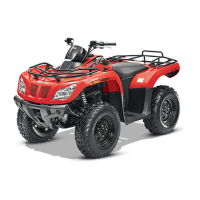
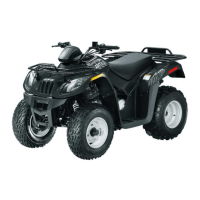
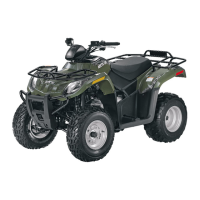


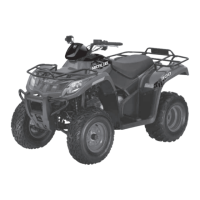
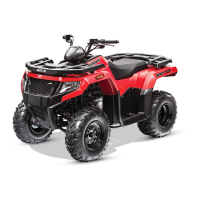
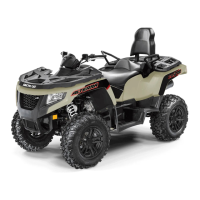

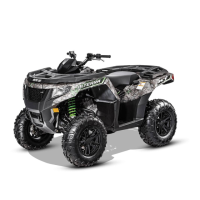
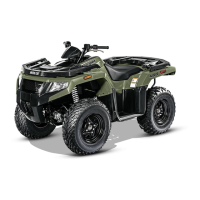
